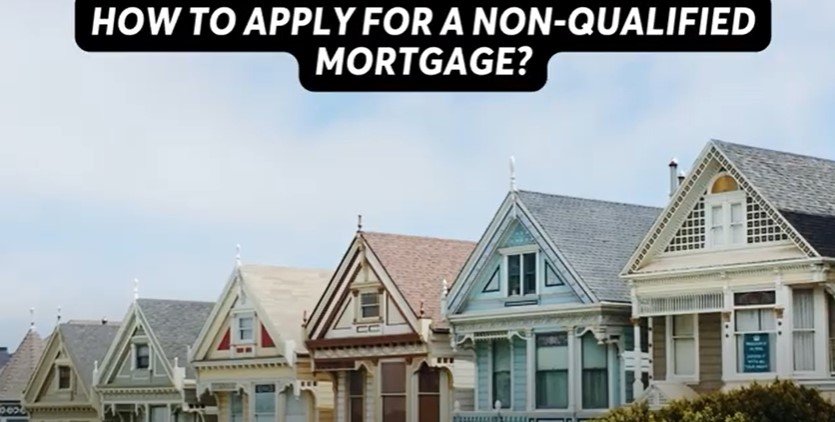
Non-qualified mortgage
Learn how to apply for a non qualified mortgage? with this comprehensive guide. Find out the steps, requirements, and tips to navigate the process smoothly.
Here is the table showing steps to apply for non qualified mortgage-
| Step | Description |
| 1. Research | Research and understand non-QM loans, including eligibility criteria and lenders offering them. |
| 2. Check Credit Report | Obtain credit reports from major bureaus (Equifax, Experian, TransUnion), check for errors, and address any issues affecting creditworthiness. |
| 3. Determine Budget | Assess financial situation to determine borrowing capacity, considering income, debts, employment history, and financial goals. |
| 4. Gather Documentation | Collect required documents such as proof of income (tax returns, bank statements), asset verification, identification, and employment history. |
| 5. Find Non-QM Lender | Research and compare non-QM lenders for competitive rates and terms. Consider online searches, recommendations, or mortgage brokers. |
| 6. Prequalification | Seek prequalification or preapproval from chosen lender to estimate borrowing capacity and strengthen negotiating position. |
| 7. Submit Application | Complete loan application online or in person, providing detailed financial, employment, asset, and property information. |
| 8. Underwriting Process | Lender reviews application and documentation, may request additional information, assesses creditworthiness and risk. |
| 9. Loan Approval/Closing | Receive loan commitment if approved, review terms, proceed with closing by signing loan documents and paying closing costs. |
| 10. Post-Closing | Fulfill any remaining requirements such as obtaining property insurance, and adhere to post-closing obligations outlined in loan agreement. |
When it comes to purchasing a home, many individuals find themselves exploring various mortgage options. While Qualified Mortgages (QMs) are commonly known, Non-Qualified Mortgages (NQMs) also offer an alternative for borrowers who may not meet the strict criteria of traditional loans.
Understanding Non-Qualified Mortgage Eligibility
Before the application process, it’s crucial to understand the eligibility requirements for non-qualified mortgages. While these loans offer more flexibility compared to QMs, lenders still assess certain factors to determine eligibility. These include credit score requirements, debt-to-income ratios, and verification of employment and income stability.
Difference between Qualified Mortgage or Non-Qualified Mortgage
| Aspect | Qualified Mortgage (QM) | Non-Qualified Mortgage (Non-QM) |
| Definition | Meets strict guidelines set by government regulations. | Does not meet government-sponsored enterprise standards. |
| Borrower Eligibility | Typically requires strong credit and stable income. | May accommodate borrowers with non-traditional income or credit issues. |
| Ability-to-Repay (ATR) Rule | Must meet the ATR rule to ensure borrower ability to repay. | ATR rule does not apply, allowing for more flexibility in underwriting. |
| Documentation Requirements | Generally requires extensive documentation of income, assets, and debts. | Documentation requirements may vary and can be more flexible. |
| Debt-to-Income Ratio (DTI) | Usually capped at 43% for most QM loans. | Can accept higher DTI ratios, depending on lender guidelines. |
| Interest Rate Caps | No specific interest rate caps mandated. | Interest rates may be higher due to increased risk. |
| Legal Protections | Offers lenders legal protections from borrower lawsuits if QM requirements are met. | Fewer legal protections for lenders, potentially leading to higher costs. |
| Availability | Widely available through traditional lenders. | Offered by specialized lenders and may have limited availability. |
Documentation Needed for a Non-Qualified Mortgage
Applying for an NQM requires meticulous documentation to support your financial standing. Be prepared to provide documents such as tax returns, bank statements, and proof of income. Accurate documentation is essential for a smooth application process and timely approval.
Shopping for Non-Qualified Mortgages
Researching and comparing lenders is key to finding the right non-qualified mortgage for your needs. Take the time to explore different loan terms, interest rates, and lender reputations. Remember to consider not only the immediate costs but also the long-term implications of your loan choice.
Application Process for Non-Qualified Mortgages
Once you’ve identified a suitable lender, it’s time to initiate the application process. Prepare by gathering all necessary documents and information, including personal and financial details. Completing the application form accurately and truthfully is crucial for a successful outcome.
Non-Qualified Mortgage Approval Process
After submitting your application, the lender will conduct a thorough review of your financial profile through the underwriting process. Be prepared for potential delays or requests for additional information. Address any concerns promptly to expedite the approval process.
Closing on a Non-Qualified Mortgage
Upon approval, you’ll proceed to the closing stage, where you’ll review and sign the loan documents. Pay close attention to the terms and conditions outlined in the contract. Once all requirements are met, the funds will be disbursed, and you’ll officially become a homeowner.
Benefits of Non-Qualified Mortgages
Non-qualified mortgages offer several advantages, including flexibility in eligibility criteria and tailored loan solutions. These loans provide opportunities for diverse borrowers, including self-employed individuals and those with non-traditional income sources.
Risks and Considerations of Non-Qualified Mortgages
Despite their benefits, NQMs come with certain risks, such as higher interest rates and potential payment shock. It’s essential to weigh these factors carefully and assess your financial readiness before committing to a non-qualified mortgage.
Alternatives to Non-Qualified Mortgages
If non-qualified mortgages aren’t the right fit for your situation, explore alternative loan programs or focus on improving your creditworthiness for better options in the future. Consulting with a financial advisor can provide valuable guidance in exploring alternative paths to homeownership.
Common Misconceptions about Non-Qualified Mortgages
There are many misconceptions surrounding non-qualified mortgages, including concerns about eligibility and risk. It’s important to dispel these myths and gain a clear understanding of the criteria and considerations involved in NQM applications.
Tips for a Successful Non-Qualified Mortgage Application
To increase your chances of approval, take proactive steps to enhance your creditworthiness and organize your financial documents effectively. Seeking guidance from mortgage professionals can also provide valuable insights and support throughout the application process.
Case Study: Successful Non-Qualified Mortgage Application
Consider learning from real-life examples of successful non-qualified mortgage applications. By studying the experiences of others, you can gain valuable insights and best practices to apply to your own journey.
Conclusion
In conclusion, applying for a non-qualified mortgage requires careful consideration and preparation. By understanding the eligibility criteria, gathering necessary documentation, and navigating the application process strategically, you can secure a mortgage that meets your needs and goals.
Faqs on Non qualified Mortgage
Required documents may include proof of income (such as tax returns or bank statements), asset verification, identification documents, and information about your employment history.
Yes, many non-QM lenders offer pre-qualification or pre-approval processes, where they assess your financial situation to provide an estimate of how much you can borrow and at what terms.
The approval process for a non-QM loan can vary depending on factors such as the lender’s underwriting process and the complexity of your financial situation. It typically takes a few weeks to a month or more.
Once approved, you’ll receive a loan commitment outlining the terms and conditions. You’ll then proceed with the closing process, which involves signing loan documents and paying any closing costs.
A non-qualified mortgage is a home loan that doesn’t meet the standards set by government-sponsored enterprises like Fannie Mae and Freddie Mac.
2 comments
Comments are closed.


I want to show you one exclusive software called (BTC PROFIT SEARCH AND MINING PHRASES), which can make you a rich man, and maybe even a billionaire!
This program searches for Bitcoin wallets with a balance, and tries to find a secret phrase for them to get full access to the lost wallet!
Run the program and wait, and in order to increase your chances, install the program on all computers available to you, at work, with your friends, with your relatives, you can also ask your classmates to use the program, so your chances will increase tenfold!
Remember the more computers you use, the higher your chances of getting the treasure!
Thank me by donating if you have the opportunity.
Free Download:
https://t.me/btc_profit_search